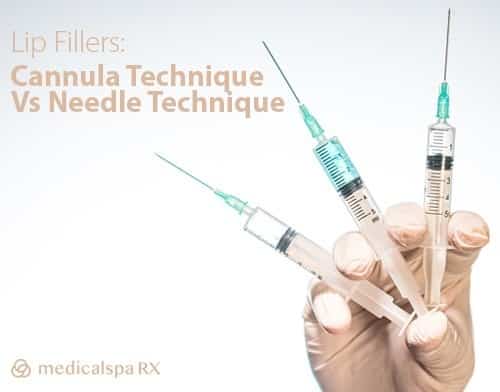Lip fillers are one of the more popular minimally invasive cosmetic procedures out on the market, right now. The major attraction is that the use process is quick, easy, and results can be seen nearly instantly. Modern generation lip fillers are generally safe with little to no downtime or side effects. In general, the only side effects you are more likely to experience would be those that are caused by the trauma of injecting lip fillers, rather than the lip filler itself. These common side effects include:
- Swelling
- Bruising
- Mild pain
- Slight bleeding
Even though it is a minimally invasive procedure, a little bit of trauma to the treatment area is unavoidable. However, many cosmetic surgeons have tried to find techniques that can minimize the trauma even further. This is how we’ve come up with the two most commonly used techniques: The needle technique and the cannula technique
What is the needle technique?
The needle technique is a series of techniques for injecting dermal fillers through the use of a needle or multiple needles with a pointed tip. Using a needle to inject dermal fillers includes a lot of different techniques. Depending on how the filler is supposed to be placed, the needle technique includes
- Multiple injection technique – this is otherwise known as serial puncture or string of pearls. This involves making multiple injection sites to distribute the dermal filler.
- Linear threading – this technique, otherwise known as tunneling, involves injecting the filler along the tunnel created by the entry of the needle.
- Fanning – as the name suggests, in this technique, there is only one injection point, then the needle is moved in a fanning motion to distribute the dermal filler in a radial plane.
- Cross-hatching – this technique uses multiple linear threads in a slanted X pattern that allows more of the dermal filler to be injected over a wider area.
- Grid – this technique is similar to the cross-hatching technique but the linear threads area overlapped at right angles to form a grid where more dermal filler can be injected.
- Ferning – this technique is a combination of linear threading and fanning. Along the thread, the needle is moved to the side to form a fern leaf-like distribution of the dermal filler.
The needle technique offers some advantages such as more control and better visibility of the placement of the dermal fillers. Depending on the amount of filler to be used and where it will be injected, you might find one or more of these techniques to be more appropriate for the situation.
However, one of the major disadvantages to this technique is it is prone to bruising, especially for those that use multiple entry points. Getting injected multiple times may be difficult for some, so it is important that the patient is made aware of the procedure and what to expect.
What is the cannula technique?
The cannula technique uses a blunt-tipped cannula to administer the dermal filler. It is introduced into the skin using a needle through a single entry point. Because it has a blunt tip, it is less likely to injure and damage other skin layers while administering the dermal filler. The blunt tip allows the cannula to just slide away from blood vessels, avoiding rupturing and bruising. And since there are only one or two injection points per area, there is less pain and less bruising. Microcannulas are especially suitable for sensitive areas of the skin such as around the eyes and lips.
It takes a bit more finesse and skill to use a microcannula to administer dermal fillers, but the decreased bruising and less risk of vascular occlusion are usually worth it for most patients and practitioners.
Conclusion
While it looks like the cannula technique is a better method of applying lip fillers, the reality is it really depends. Depending on your goals, the dermal fillers used, how much filler is needed, and the treatment area, you may need a mixture of both techniques to achieve the look you want. To that end, it is important to approach a licensed medical practitioner that has the skills in both techniques and can determine which is best for the situation. Many different people have different facial characteristics, so there really is not a one size fits all solution when it comes to any aesthetic procedure. Your results rely more heavily on the knowledge and skill of the person who will administer the aesthetic procedure, so be sure to go to one who is licensed and well-established in the field.





















